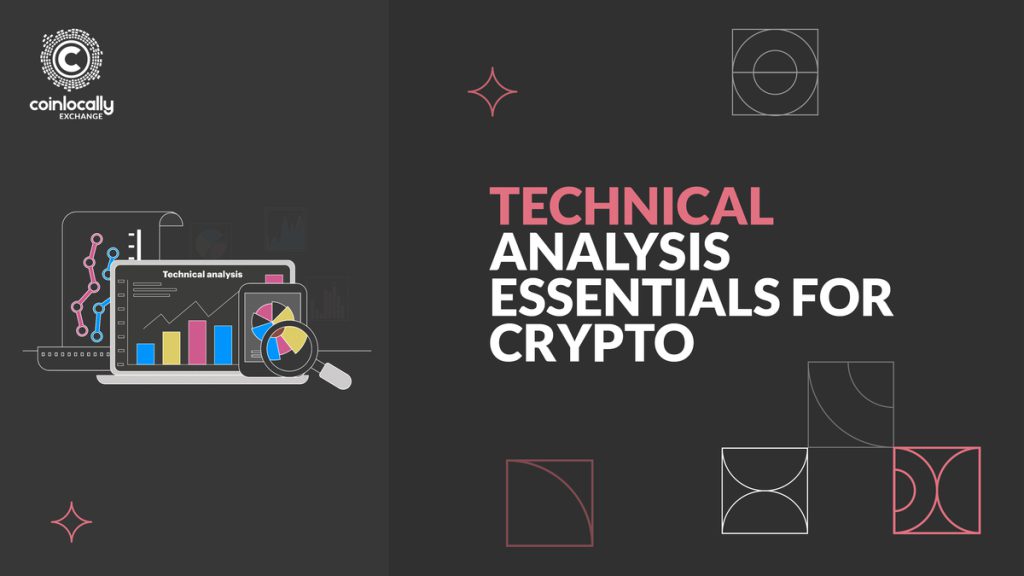Technical Analysis Essentials for Crypto is a powerful tool that enables market participants to evaluate past price movements, identify trends, and make informed predictions about future price action. By analyzing historical data, chart patterns, and various technical indicators, traders can gain valuable insights into market behavior and potentially improve their trading strategies.
Throughout this guide, we will also discuss the unique characteristics of the crypto market and how they may impact technical analysis. Crypto markets are known for their high volatility, market manipulation, and rapid price movements, which necessitate specific considerations when applying technical analysis techniques.
Quick Getaway: Looking for a safe platform that offers the most secure cryptocurrency trading platform? Signup with Coinlocally and enjoy the best Crypto Trading Bot.
Table of Contents
• Technical Analysis Essentials for Crypto
• Essential Crypto Trading Indicators
• Crypto Market Analysis Tools
• Fundamental Indicators for Cryptocurrency
Technical Analysis Essentials for Crypto
In the fast-paced and volatile world of cryptocurrencies, Technical Analysis Essentials for Crypto plays a crucial role in helping traders and investors make informed decisions. By analyzing historical price data, patterns, and indicators, technical analysis aims to identify trends and predict future price movements.
It is important to note that while technical analysis essentials for crypto can provide valuable insights into market trends and potential trading opportunities, it is not a foolproof method for predicting future price movements. The crypto market is influenced by various factors, including regulatory developments, macroeconomic events, and investor sentiment, which can sometimes render technical analysis less effective.
Nonetheless, by mastering the technical analysis essentials for crypto, you will be equipped with valuable tools to help you navigate the ever-changing landscape of the crypto market with more confidence and precision. In this guide, we will explore the essential elements of technical analysis specifically tailored for the crypto market.
1. Candlestick Charts:
Candlestick charts provide a visual representation of price movements over a specific time period. Understanding how to interpret candlestick patterns, such as doji, hammer, and engulfing patterns, can provide insights into market sentiment and potential reversals.
2. Support and Resistance Levels:
Support levels indicate the price level at which buying interest is expected to emerge, preventing the price from declining further. Resistance levels, on the other hand, represent price levels where selling pressure is anticipated, preventing the price from rising further. Identifying these levels helps traders make decisions about entry and exit points.
3. Trend Analysis:
Identifying trends is crucial in crypto trading. An uptrend consists of higher highs and higher lows, while a downtrend consists of lower highs and lower lows. By understanding the overall trend, traders can align their strategies with the market direction.
4. Moving Averages:
Moving averages smooth out price data and help identify the underlying trend. Commonly used moving averages include the simple moving average (SMA) and the exponential moving average (EMA). Crossovers between different moving averages can signal potential buying or selling opportunities.
5. Oscillators:
Oscillators, such as the Relative Strength Index (RSI) and the Moving Average Convergence Divergence (MACD), help traders identify overbought or oversold conditions in the market. These indicators can assist in predicting potential trend reversals or price corrections.
6. Volume Analysis:
Analyzing trading volume can provide insights into market strength and the level of investor participation. Unusual volume spikes may indicate significant market moves or the presence of institutional investors.
7. Fibonacci Retracement:
Fibonacci retracement levels are based on mathematical ratios and are used to identify potential support and resistance levels. Traders often use these levels to determine entry and exit points during price corrections.
8. Pattern Recognition:
Chart patterns, such as triangles, head and shoulders, and double tops/bottoms, can offer valuable insights into future price movements. These patterns are formed by the collective behavior of traders and can signal potential trend reversals or continuations.
9. Risk Management:
While technical analysis essentials for crypto provide valuable insights, it is essential to incorporate proper risk management strategies. Setting stop-loss orders, managing position sizes, and maintaining a disciplined approach are crucial for long-term success in crypto trading.
It is important to remember that technical analysis essentials for crypto are not infallible and should be used in conjunction with other forms of analysis and market research. Crypto markets are influenced by various factors, including regulatory changes, news events, and market sentiment, which can impact price movements.
Essential Crypto Trading Indicators
When it comes to crypto trading, there are several indicators that traders often find useful for technical analysis essentials for crypto, identifying potential entry and exit points, and making informed trading decisions. Here are some essential crypto trading indicators:
1. Relative Strength Index (RSI):
The RSI is a popular momentum oscillator that measures the speed and change of price movements. It oscillates between 0 and 100 and is used to identify overbought and oversold conditions in the market. Traders often look for divergences between the RSI and price action to anticipate potential trend reversals.
2. Moving Averages (MA):
Moving averages are used to smooth out price data and identify the underlying trend. Commonly used moving averages include the simple moving average (SMA) and the exponential moving average (EMA). Traders often look for crossovers between different moving averages, such as the 50-day and 200-day moving averages, to identify potential buy or sell signals.
3. Bollinger Bands:
In addition to technical analysis essentials for crypto, Bollinger Bands consist of a moving average (usually the 20-day SMA) and two standard deviation bands above and below the moving average. They help traders visualize the volatility of the price and identify potential overbought or oversold conditions. When the price reaches the upper band, it may indicate overbought conditions, while reaching the lower band may indicate oversold conditions.,
4. MACD (Moving Average Convergence Divergence):
The MACD is a trend-following momentum indicator that shows the relationship between two moving averages of the price. It consists of a MACD line (the difference between a short-term and a long-term moving average) and a signal line (usually a 9-day EMA). Traders look for crossovers and divergences between the MACD line and the signal line to identify potential buy or sell signals.
5. Volume:
Besides technical analysis essentials for crypto, volume is a crucial indicator in trading as it represents the number of shares or contracts traded in a given period. In crypto trading, analyzing volume can provide insights into the strength of price movements and the level of market participation. Unusual volume spikes often indicate significant market moves and can help traders confirm the validity of price trends or anticipate potential reversals.
6. Fibonacci Retracement:
Fibonacci retracement levels are based on mathematical ratios and are used to identify potential support and resistance levels. Traders use these levels to determine potential price targets or areas where the price may find support or resistance during pullbacks or corrections.
7. Ichimoku Cloud:
The Ichimoku Cloud is a comprehensive indicator that provides insights into support and resistance levels, trend direction, and momentum. It consists of multiple components, including the Kumo (cloud), Tenkan-sen (conversion line), and Kijun-sen (baseline). Traders look for various signals within the Ichimoku Cloud, such as the price crossing above or below the cloud, to identify potential trend reversals or continuations.
8. Average True Range (ATR):
The ATR measures market volatility by calculating the average range between high and low prices over a specific period. It helps traders identify potential price targets and determine appropriate stop-loss levels based on the current market volatility.
Remember, no single indicator can guarantee profitable trades, and it is essential to use indicators in conjunction with other forms of technical analysis essentials for crypto and risk management strategies. Additionally, different indicators may work better in specific market conditions, so it’s crucial to adapt your approach and use indicators that align with your trading style and the crypto assets you’re trading.
Crypto Market Analysis Tools
The crypto market is known for its fast-paced and dynamic nature, requiring traders and investors to stay informed and make data-driven decisions. To aid in market analysis, there are several tools available specifically designed for analyzing the crypto market. Here are some popular tools and technical analysis essentials for crypto:
1. CoinMarketCap:
As an important tool for technical analysis essentials for crypto, CoinMarketCap is one of the most widely used platforms for tracking and analyzing cryptocurrencies. It provides real-time data on market capitalization, price, trading volume, and other key metrics for thousands of cryptocurrencies. Traders can use CoinMarketCap to monitor price movements, perform comparative analysis, and access historical data.
2. CoinGecko:
CoinGecko is another popular cryptocurrency data platform that offers comprehensive market data, including price charts, market capitalization, trading volume, and liquidity. It provides additional features such as portfolio tracking, yield farming information, and a “trust score” to help users evaluate the credibility of projects.
3. TradingView:
As another tool for technical analysis essentials for crypto, TradingView is a widely used charting platform that offers real-time data and advanced charting tools for a variety of financial markets, including cryptocurrencies. Traders can access a wide range of technical indicators, and drawing tools, and customize their charts to perform in-depth technical analysis. TradingView also has a social community where users can share ideas and analysis.
4. CryptoCompare:
CryptoCompare is a cryptocurrency data platform that provides real-time and historical data on prices, trading volume, market capitalization, and other metrics. It offers a range of tools for traders, except, technical analysis essentials for crypto, including portfolio tracking, price alerts, and news aggregation. CryptoCompare also provides comprehensive data on crypto exchanges, allowing users to compare fees, liquidity, and other important factors.
5. Coinigy:
Coinigy is a trading and portfolio management platform that integrates with multiple cryptocurrency exchanges. It offers a unified interface to access real-time market data, execute trades, and manage portfolios across different exchanges. Coinigy provides advanced charting tools, price alerts, and API integrations for automated trading strategies.
You may also want to learn about the Best Futures Trading Strategy.
6. OnChainFX:
OnChainFX is a data platform focused on providing fundamental analysis metrics for cryptocurrencies. It offers insights into market capitalization, trading volume, circulating supply, and other fundamental data points. OnChainFX allows users to compare cryptocurrencies based on various metrics and provides historical data for analysis.
7. Santiment:
Santiment is a data analytics platform that specializes in providing market insights and sentiment analysis for cryptocurrencies. It offers data on social media mentions, developer activity, on-chain metrics, and market sentiment indicators. Santiment aims to help traders and investors make data-driven decisions by providing unique insights into market trends and sentiment.
These are just a few examples of the many technical analysis essentials for crypto. It’s important to explore and experiment with different tools to find the ones that suit your specific needs and trading style. Combining multiple tools and approaches can provide a more comprehensive view of the market and improve your decision-making process.
Fundamental Indicators for Cryptocurrency
While technical analysis essentials for crypto focus on price and market patterns, fundamental analysis examines the underlying factors that can affect the value and long-term prospects of a cryptocurrency. Here are some fundamental indicators that can be used to analyze cryptocurrencies:
1. Team and Development:
Assess the credentials and experience of the project team behind the cryptocurrency. Look for a strong technical team with expertise in blockchain technology. Evaluate their track record, past projects, and contributions to the crypto community. Additionally, consider the level of ongoing development and updates to the project’s codebase.
2. Technology and Innovation:
Examine the technical analysis essentials for crypto, such as its underlying blockchain, consensus mechanism, scalability solutions, and privacy features. Assess whether the technology solves real-world problems or offers unique advantages over existing solutions. Keep an eye on any technological advancements or partnerships that could enhance the project’s potential.
3. Use Case and Adoption:
Evaluate the practical application and real-world use case of the cryptocurrency. Consider whether it addresses a specific problem or provides value in a particular industry. Look for evidence of adoption by businesses, institutions, or governments, as widespread adoption can contribute to long-term value appreciation.
4. Market Cap and Circulating Supply:
Market capitalization represents the total value of a cryptocurrency. Consider the market cap relative to other cryptocurrencies to understand its position in the market. Additionally, analyze the circulating supply to assess the potential for price appreciation or dilution due to new token issuance.
5. Partnerships and Integrations:
Look for strategic partnerships and collaborations that can enhance the cryptocurrency’s adoption and utility. Partnerships with reputable companies or integration into existing platforms can provide validation and open up new avenues for growth.
6. Regulatory Environment:
Consider the regulatory landscape surrounding cryptocurrency. Regulatory clarity and support from governments can positively impact long-term prospects. Conversely, regulatory challenges or restrictions can pose risks and hinder adoption.
7. Community and Social Sentiment:
Assess the strength and engagement of the cryptocurrency community and technical analysis essentials for crypto, analyze social media channels, forums, and online communities to gauge sentiment, and monitor discussions around the project. Positive community sentiment and active participation can contribute to the project’s success.
8. Financials and Tokenomics:
Analyze the financial aspects of the project, including the funding mechanism, token distribution, and economic incentives. Evaluate the tokenomics to understand the token’s utility, scarcity, and potential for value appreciation. Consider factors such as token issuance schedules, staking mechanisms, and token burn policies.
It’s important to note that technical analysis essentials for crypto are subjective and require continuous research and monitoring. Moreover, the cryptocurrency market is highly speculative and can be influenced by various external factors. Therefore, combining fundamental analysis with other forms of technical analysis essentials for crypto, such as technical analysis and market sentiment, can provide a more comprehensive understanding of a cryptocurrency’s potential.
Crypto Trading Signals and Strategies
In addition to technical analysis essentials for crypto, crypto trading signals, and strategies are tools and approaches used by traders to make informed decisions about buying, selling, or holding cryptocurrencies. Here are some popular crypto trading signals and strategies:
1. Trend Following:
This strategy involves identifying and following the prevailing trend in the market. Traders use technical indicators like moving averages, trend lines, or the Ichimoku Cloud to determine the direction of the trend. They then enter positions in line with the trend, aiming to ride the momentum until signs of a trend reversal appear.
2. Breakout Trading:
Breakout trading involves identifying key support or resistance levels on a price chart. Traders anticipate a breakout when the price breaches these levels, signaling a potential shift in market sentiment. They may enter a trade when the price breaks above resistance (bullish breakout) or below support (bearish breakout), expecting the price to continue in the direction of the breakout.
3. Range Trading:
Range trading is a strategy used when the price of a cryptocurrency is consolidating within a defined range. Traders identify the upper and lower boundaries of the range and execute trades near these levels. They buy at support and sell at resistance, aiming to profit from price oscillations within the range.
4. Mean Reversion:
Mean reversion strategies assume that the price of a cryptocurrency will eventually revert to its average or mean value. Traders identify overbought or oversold conditions using indicators like the Relative Strength Index (RSI) or Bollinger Bands. They enter trades when the price deviates significantly from the mean, expecting it to return to its average value.
5. Scalping:
Scalping is a short-term trading strategy where traders aim to profit from small price movements. They enter and exit trades quickly, often within minutes or seconds, capturing small gains multiple times throughout the day. Scalping usually relies on technical analysis and can be facilitated by low trading fees and fast order execution.
6. News Trading:
News trading involves reacting to significant news events or developments that can impact the cryptocurrency market. Traders closely monitor news sources and announcements and enter trades based on the anticipated market reaction. This strategy requires quick decision-making and can be associated with higher volatility and risks.
7. Swing Trading:
Swing trading involves capturing medium-term price movements within an established trend. Traders aim to identify price swings or corrective moves within the larger trend and enter trades accordingly. They may use technical indicators, chart patterns, or a combination of both to time their entries and exits.
8. Diversification:
Diversification is a risk management strategy that involves spreading investments across multiple cryptocurrencies or other assets. By diversifying their portfolio, traders aim to reduce the impact of individual asset price movements and potentially achieve more stable returns.
No trading signal or strategy guarantees profits, and trading involves risks. In addition to technical analysis essentials for crypto, traders should conduct thorough research, practice proper risk management techniques, and adapt their strategies to changing market conditions. Additionally, backtesting and demo trading can be helpful in evaluating the effectiveness of different signals and strategies before applying them to live trading.
You may also like to be familiar with the Best Crypto trading Bot for Beginners.
Conclusion
Technical analysis essentials for crypto are valuable tools for analyzing and understanding the price movements of cryptocurrencies. By studying historical price data, identifying patterns, and using various indicators and charting techniques, traders can make more informed decisions about buying, selling, or holding cryptocurrencies.
Technical analysis essentials for crypto include understanding key concepts such as support and resistance levels, trend lines, chart patterns, and various technical indicators. These tools can help traders identify potential entry and exit points, gauge market sentiment, and anticipate price movements.
However, it’s important to recognize that technical analysis essentials for crypto are not foolproof and don’t guarantee accurate predictions. The cryptocurrency market is highly volatile and influenced by various factors, including market sentiment, news events, regulatory developments, and broader economic trends. Therefore, combining technical analysis with other forms of analysis, such as fundamental analysis and market sentiment, can provide a more comprehensive view of the market.
Moreover, it’s crucial for traders to practice proper risk management techniques, including setting stop-loss orders and diversifying their portfolio. Additionally, continuously updating one’s knowledge and staying informed about the latest developments in the crypto industry is essential for adapting and refining technical analysis strategies over time.




![FTM to Sonic Price Prediction After Upgrade [All Possible Scenarios]](https://blog.coinlocally.com/wp-content/uploads/2025/01/FTM-to-Sonic-Price-Prediction-After-Upgrade-All-Possible-Scenarios-Custom.jpeg)

